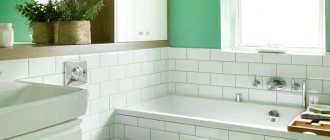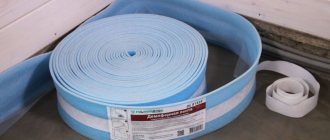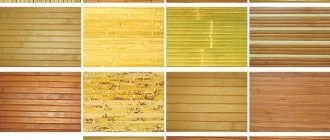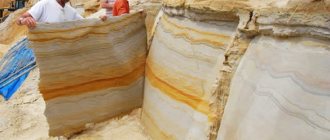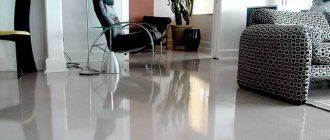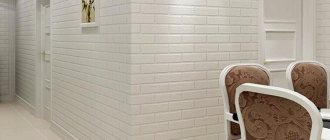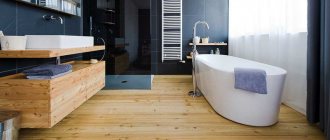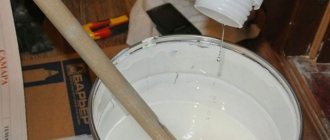PVC floor tiles or LVT (Luxury Vinyl Tile) are a popular type of vinyl flooring with a multi-layer structure, in which the main role is played by a layer of polyvinyl chloride. Vinyl tiles are elastic and thin (2-5 mm), available in tiles or planks, and can be of the locking or adhesive type. In Russia, LVT is often equated with quartz vinyl tiles, which is not entirely correct: quartz sand is found only in quartz vinyl. But in terms of performance characteristics, these two types of vinyl flooring are very similar to each other, only quartz vinyl is denser and dents less, and LVT is more flexible and impact-resistant.
This article describes heterogeneous (multilayer) PVC tiles, which appeared in the early 90s. But even earlier, in the USSR, they used homogeneous (single-layer) vinyl - an indestructible and very cheap floor covering for mass demand. A separate article from Doctorfloor.ru is devoted to the evolution of vinyl floors.
It is very simple to distinguish PVC tiles from quartz vinyl: in the section of LVT, a monolithic structure is visible, and in the section of quartz vinyl flooring there is a clear separation into layers and particles of quartz.
What are vinyl tiles and PVC floor tiles?
Vinyl tiles appeared on the market relatively recently, but have already become popular among interior finishing specialists. It can be compared to linoleum cut into squares or rectangles. But the manufacturing technology of such flooring differs from linoleum.
It's all one. Vinyl tile is a PVC floor covering that is a multi-layer material that is flexible and dense at the same time. The base layers include vinyl and resins in combination with stabilizers, plasticizers and fillers.
The mass is pressed into molds, then a film with a pattern is applied, a transparent PVC film creates a protective layer, and a layer of polyurethane is added on top, making the product wear-resistant.
There are two types of PVC tiles:
- vinyl;
- quartz-vinyl - has particular wear resistance, but its cost is much higher than vinyl.
Vinyl floor tiles have another advantage: they are cut into squares or rectangles that are easy to install and match. The cost of the material is quite high, but by calculating the required number of tiles, you can minimize the remaining scraps.
Some LVT vinyl manufacturers
Aquafloor
✔ Go to Aquafloor review.
All adhesive collections are produced in the PVC structure, including the chic herringbone parquet Aquafloor Parquet Glue, as well as the unique collection of interlocking vinyl flooring Nano 43 wear resistance class with a thickness of only 3.2 mm. Note that Aquafloor offers all types of vinyl floors except quartz vinyl tiles: SPC vinyl Art, Quartz and Stone, as well as WPC and Rigid Vinyl.
Fine Flex
✔ Go to Fine Flex review.
Economy collection of Russian-made adhesive LVT tiles from the supplier Fine Floor Rus. Fiberglass is integrated into the structure for stability, and the decors are named after stunning natural places in Russia.
Tarkett
Another Russian manufacturer with a very wide range of various adhesive-type vinyl floor coverings, including collections with a 0.7 mm protective layer. The Art Vinyl line also has 4 collections of SPC laminate: Deep House, Jazz Click, Progressive House, Dream House.
Vertigo
Chinese manufacturer of commercial LVT tiles (wear-resistant layer 0.7 mm) with a wide variety of designs: wood, stone, canvas, herringbone parquet, porcelain stoneware. Floor coverings are available in all installation methods: adhesive, Uniclic joints, free-standing tiles. Vertigo specializes exclusively in LVT coatings.
Vinilam
✔ Go to Vinilam review.
In 2022, the Vinilam brand updated its main range of elastic vinyl - two collections, 23 duplicated in adhesive and locking decor with imitation of valuable wood species. In addition, Vinilam Ceramo Glue XXL and Stone (decors from the SPC collections of the same name) are produced on an LVT basis. In addition to PVC tiles, Vinilam’s assortment includes SPC laminate Ceramo, Rigid Vinyl and WPC tiles.
Kinds
PVC floor tiles differ in the installation method:
- with a self-adhesive base or without an adhesive layer, for installation of which you additionally need to purchase special glue. For such tiles, it is necessary to prepare a flat surface and lay them strictly in the joint. The result is a coating that is firmly attached to the floor;
- with a lock fastening to each other. Locks can be mechanical or adhesive, with the help of which each tile is fastened to each other and does not require gluing to the base.
Areas of use of polyvinyl chloride coatings
The scope of use of polyvinyl chloride is quite extensive. Depending on the location for which the slabs will be used, manufacturers provide them with the necessary technical characteristics.
It can be used when installing a warm water floor indoors, which is especially important for private country buildings and apartments located on the ground floors.
By area of application, several types of vinyl can be distinguished:
- Special plates. They are immune to acids, fire resistant and do not conduct electricity. Special plates are used in industrial production and laboratories.
- Household. The technical indicators of this type of slabs are not very high; they take more into account the aesthetic side.
- Semi-commercial. The strength of such slabs is slightly stronger than that of household ones. It is recommended to lay them in rooms with average physical activity.
- Commercial. They are characterized by high wear resistance and a long service life. They are laid in areas with high physical activity.
Thanks to its harmlessness and high resistance to high humidity, the tiles will retain their aesthetics for a long time in difficult conditions.
Household and utility rooms
Most often, in these types of premises, PVC boards with the lowest level of protective layer are used. They are called household ones. In terms of load, this is class 23-31.
A wide range of products allows you to choose flooring to suit any room interior.
Temporary flooring
Vinyl is in great demand as temporary flooring during various events, such as presentations and exhibitions. It is very easy and quick to install, just as it is assembled.
Plastic tile flooring is durable, making it suitable for use in industrial workshops, exhibition centers, and retail outlets.
How to choose PVC tiles
When choosing tiles, several factors should be taken into account, for example, environmental friendliness if we are talking about decorating a children's room, wear resistance for places where furniture on wheels will be used, etc. In the case of wear resistance, pay attention to the class, information about which the manufacturer indicates on the packaging.
There are several classifications of vinyl tiles:
- class 21-32 is considered the most inexpensive and less durable; the protective coating is thin and its use is limited to minimal mechanical stress (suitable for bedrooms and living rooms);
- class 33-42, such tiles are quite thick and reliably protected by a durable layer, allowing the use of furniture on wheels (optimal for the kitchen, bathroom and corridor);
- For industrial facilities with intense impact, class 43 is suitable; for a home there is no point in taking it, primarily because of the high price.
To avoid different shades of PVC tiles, it is recommended to buy the same series.
Consumer Reviews
Despite the fact that PVC tiles have been used for a relatively short time, there are many consumer reviews on the Internet describing their use:
Detailed report on the installation and operation of FineFloor PVC tiles:
More details on Otzovik: https://otzovik.com/review_4025634.html
FineFloor PVC tiles
Review of Tarkett “Lounge” vinyl tiles:
More details on Otzovik: https://otzovik.com/review_4190458.html
Tarkett Lounge Vinyl Tile
Review of quartz vinyl PVC tiles Art Tile:
More details on Otzovik: https://otzovik.com/review_1071990.html
Quartz Vinyl PVC Tiles Art Tile
Review of Tarkett “New Age” PVC vinyl tiles:
More details on Otzovik: https://otzovik.com/review_5165800.html
Tarkett New Age PVC Vinyl Tiles
Dimensions
Tiles vary in thickness, width and length. When selecting, special attention must be paid to the thickness of the material: single-layer models are usually in the range of 1.5-2.5 mm. They are less durable due to the lack of a backing and a thick protective layer.
Higher quality models in terms of durability reach thicknesses of up to 5 mm. Moreover, the material on a foamed PVC backing behaves well in wet rooms, while the material on a warm backing is suitable for dry rooms.
The dimensions of square tiles can be (cm):
- 30x30,
- 50x50,
- 65x65.
Therefore, it is quite easy to choose one for your room, knowing the area of the surface to be covered.
Collection characteristics
| Brand | Collection (links - descriptions) | Class; protective layer, mm | Plank or tile, mm | Thickness, mm | Packaging, m2 (pcs.) | Laying | Decors | Chamfer |
| Aquafloor | Classic Glue | 43; 0,5 | 177.8x1219.2 | 2 | 3,252 (15) | Adhesive for PVC coatings | Tree | No |
| Real Wood Glue | 177.8x1219.2 | 2 | 4,335 (20) | Wood, synchronous embossing | No | |||
| Parquet Glue | 122x610 | 2,5 | 3,72 (50) | Herringbone parquet, synchronous embossing | Yes | |||
| Nano Click | 180x1221 | 3,2 | 3,52 (16) | EasyLock | Wood, synchronous embossing | No | ||
| Fine Flex | Wood | 42; 0,5 | 140x940 | 2,2 | 3,03 (23) | Adhesive for PVC coatings | Tree | No |
| Tarkett Art Vinyl | Blues | 43; 0,7 | 152x914 | 3 | 2,09 (15) | Tree | Yes | |
| 457x457 | 2,09 (10) | Stone | Yes | |||||
| Cosmic | 152x914 | 3 | 2,09 (15) | Tree | Yes | |||
| Epic | 42; 0,55 | 152x914 | 2,7 | 2,09 (15) | Tree | Yes | ||
| Jazz | 41; 0,4 | 152x914 | 2,1 | 2,5 (18) | Tree | Yes | ||
| New Age | 152x914 | 2,1 | 2,5 (18) | Tree | No | |||
| 457x457 | 2,5 (12) | Stone | ||||||
| Lounge | 43; 0,7 | 152x914 | 3 | 2,09 (15) | Tree | Yes | ||
| 457x457 | 2,09 (10) | Stone | ||||||
| Lounge Digi Edition | 152x914 | 3 | 2,09 (15) | Abstractions | Yes | |||
| 457x457 | 2,09 (10) | |||||||
| Vertigo | Trend Wood | 43; 0,7 | 152.4x914.4 | 2,5 | 3,34 (24) | Tree | No | |
| 184.2x1219.2 | 3,37 (15) | |||||||
| Trend Chevron | 228.6x2x1219.2 | 2,5 | 3,34 (12) | Herringbone parquet | No | |||
| Trend Wood EIR | 228.6x2x1219.2 | 2,5 | 3,34 (12) | Wood, synchronous embossing | Yes | |||
| Trend Stone & Design | 457.2x457.2 | 2,5 | 3,34 (16) | Stone, canvas | No | |||
| 457.2x914.4 | 3,34 (8) | |||||||
| Trend Gres | 457.2x457.2 | 2,5 | 3,34 (16) | Porcelain tiles | No | |||
| Loose Lay Wood | 184.2x1219.2 | 5 | 1,8 (8) | Free-standing floor | Tree | Yes | ||
| Loose Lay Stone | 457.2x457.2 | 2,09 (10) | ||||||
| 914.4x914.4 | 3,34 (4) | Stone, canvas | ||||||
| Click Wood | 31; 0,3 | 180x1220 | 3,2 | 3,07 (14) | Uniclic lock | Tree | No | |
| Vinilam | Click | 43; 0,5 | 181x1220 | 3,7 | 3,09 (14) | Lock | Wood, synchronous embossing for some EIR decors | Yes |
| Glue | 188x1228 | 2,5 | 4,16 (18) | Adhesive for PVC coatings | ||||
| Ceramo XXL | 233x1528 | 4,27 (12) | ||||||
| Ceramo Stone | 480x950 | 4,56 (10) | Stone, wood |
Subscribe to the mailing list of new articles and reviews from Doctorfloor.ru
The editors do not claim to have the only correct and correct opinion regarding PVC floor tiles. If you think that you have more professional, complete and reliable information, contact us by e-mail or through the feedback form in the Contacts section. We will be grateful for your help in filling the resource!
Similar articles
Vinyl flooring on rigid WPC base
Quartz vinyl floor tiles
Vinyl SPC laminate
Advantages and disadvantages
Any floor covering has its strengths and weaknesses. The advantages of PVC vinyl tiles include:
- ease of installation, when during the installation process there is no need to clear the entire surface of the floor from furniture, it can be rearranged into free space already covered with tiles;
- high performance characteristics;
- easy to maintain, the tiles are not afraid of moisture and detergents. When laid correctly, the joints are reliably sealed and do not allow water to pass through;
- The material is warm and non-slip. This floor can be laid in a bathroom with imitation tiles, but no discomfort will be felt;
- has soundproofing properties;
- does not deform during operation;
- the coating is not afraid of falls from sharp and heavy objects (especially the quartz vinyl version);
- low cost compared to other modern floor coverings;
- Despite the lack of natural ingredients, it is environmentally friendly.
Disadvantages are limited to the following items:
- it is necessary to carefully prepare the surface before laying the tiles, especially for thin options;
- not suitable for use on top of heated floors, with the exception of special models;
- When cleaning, do not use acetone-based substances.
The 10-year service life declared by the manufacturers has not yet been confirmed in practice.
Pros and cons of vinyl
Based on user reviews, good vinyl material has a number of advantages:
- Easy to install. Almost anyone can cope with laying quartz-vinyl coating. No specific tools or knowledge required. This does not depend on the installation method; the main thing is to study the advice of the finishers in advance and apply them in practice.
- No need to remove furniture. It is enough to simply move it to one part of the room, and after laying the vinyl PVC tiles, move it again to its place.
- Highly durable coating. Withstands high loads and does not deform when exposed to external influences.
- Tightness. The choice of material is justified by the complete isolation of the base. Regardless of the installation method, the floor covering completely covers the subfloor, preventing moisture from entering, heat and extraneous sounds.
- Ease of daily care. For housewives, this is an affordable flooring option; vinyl does not require special treatment. Wash regularly with clean water and added disinfectant (do not use abrasive cleaning products).
- Pleasant feeling when walking. The choice of users is towards softness. Unlike ceramic tiles, quartz-vinyl flooring is pleasant to walk on with bare feet. It is elastic and warm, even when wet it is not slippery, which is safe for others.
- Good soundproofing properties. The tiles are laid without additional screed or backing, directly on the concrete floor. However, the coating creates an excellent soundproofing layer that does not allow extraneous sounds into the apartment or office. When walking around an office or home, the sounds of footsteps are muffled due to the flexibility of the slats.
- Quartz vinyl is flexible. When sharp objects fall, there will be no mechanical damage on the tile; it literally pushes them away from itself without being affected.
Among the disadvantages, only the relatively high cost of the floor covering, its unnaturalness and the inability to evaluate the technical characteristics in the future are highlighted. This is easily explained: quartz-vinyl is a new material, it is chosen only by advanced users who are familiar with the range.
Laying methods
The simplest option is considered to be conventional joint-to-joint installation. To imitate wooden floors, tiles can be laid offset. It can be half or a third of the “board”, which looks good in any room. To create the effect of parquet, the planks are placed in a herringbone pattern.
Standard laying schemes:
Schemes and options for laying vinyl tiles from Tarkett
Tiles of contrasting color will enliven the space of the room and make it brighter. And shades of the same color will create a luxurious interior.
A combination of tiles that imitate different materials, such as stone and wood, will become an original solution for a kitchen or hallway.
Using PVC tiles, you can even create the effect of a carpet or a unique mosaic on the floor. Some types have intricate designs, which designers use to create a fun-filled interior.
Conclusion
PVC floor tiles are characterized by excellent water resistance and ease of installation. Without abrasion or fading, it will last at least 10–15 years. At the same time, the existing variety of patterns allows you to choose it to suit any style in the interior.
Watch also the video on how to glue PVC tiles
Read about our other materials:
Facade panels for home decoration
Connecting the washing machine drain to the sewer
General recommendations
- When starting work on laying vinyl tiles, pay attention to the microclimate of the room: air humidity should be no more than 60%, the temperature should not be lower than 20 ° C while maintaining these parameters during the day after finishing work.
- Before using the material, it is necessary to empty it from the packaging and let it rest indoors for 24 hours.
- Floor humidity should be no more than 5%. If you don't have a moisture tester, use a piece of polyethylene and stick it to the floor with masking tape for a day. If condensation does not form afterwards, then you can begin work.
- Drafts are not allowed.
- In a room with high humidity, it is recommended to treat the base with an anti-fungus and mold agent.
Format
The most common formats of PVC tiles are:
- square – side size varies from 30 to 60 cm;
- in the form of a board under laminate - there are standardized sizes 10x92, 18x92, 30x60 cm;
- modular - has a square shape, and locking connections are formed along the edges;
- hexagonal and triangular - as a rule, these are high quality products used in residential premises. With their help, you can create a floor covering with an original design.
The process of laying modular PVC tiles
Dimensions of triangular tiles and how to use them in the interior
Installation
After selecting and purchasing the material, the first thing you need to do before installation is to prepare the base for laying PVC tiles. Vinyl tiles are not picky about the base material, but it should be as smooth as possible. It is easy to install on:
- concrete base,
- plywood,
- Fiberboard, etc.
It is recommended to add a layer of gypsum mixture to the concrete screed to add rigidity to the base.
The wooden floor must first be leveled with sheets of plywood 12-15 mm thick. Please note that there should be a gap of 2-3 mm between the sheets, taking into account thermal expansion, the fasteners are recessed. All joints must be thoroughly puttied. The best option for this would be acrylic putty, which is smooth and elastic. Additionally, the surface can be primed to reduce glue consumption.
The tiles are laid on a dry base without dust and dirt.
When choosing an adhesive, it is necessary to take into account not only the characteristics of the PVC tile, but also the base material on which it is laid.
PVC adhesive tiles
Before you start working directly with the tiles, you need to decide on the laying method. You can first lay them out on the floor and evaluate how the drawing will look and avoid defects on the front side. Then mark the lines according to the given dimensions to make it easier to glue the tiles.
Eliminate exposure to direct sunlight on the base by covering window openings with thick cloth or paper. When the sun's rays hit the base, it dries unevenly, which will affect the result of the work.
Decide how the adhesive will be applied to the surface of the tile. The area of its application will depend on the open holding time set by the manufacturer for a specific brand of glue. Avoid a double layer of glue; to do this, remove any excess glue that has been squeezed onto the base.
Laying PVC plates on top of linoleum or ceramic tiles is not allowed.
Step-by-step instruction:
- Proceed with laying the plates, following the design.
- First, the first tile or small area of the floor is treated with glue and placed strictly along the drawn line.
- The glue is applied in an even layer and spread with a fine-toothed spatula. In general, follow the instructions on the package; some types of glue require pre-drying.
- Gently smooth out to expel air.
- Fitting the joint tightly, the second tile is laid, etc. To prevent them from moving during work, you can use masking tape.
- A pressure roller or block is necessary to smooth each layer and remove air that may get between the tile and the base.
- Then leave until the glue dries completely, following the time indicated on the package. Approximately 72 hours; before this time has elapsed, it is not recommended to remove the masking tape.
If the coverage area is more than 10 sq.m. For better adhesion and removal of air that could get between the base and the coating, roll over the entire surface with rollers. Repeat rolling again after 20-30 minutes.
The video details how to cover a floor with flexible vinyl tiles.
Self Adhesive Vinyl Tiles
Working with a material that has an adhesive layer is considered easier.
The protective layer is removed from each part and laid strictly along the intended lines. From the center of the room in the direction from the door to the far side. Observe the direction in which vinyl tiles are laid.
You should carefully remove the air from under the tiles and smooth each one for better adhesion to the base. To do this, first glue the side part, hold the other part in the air and gradually smooth it down. The tiles should fit snugly against each other.
Interlocking Vinyl Tile
PVC tiles with a lock should be laid from the wall, leaving a small gap of a few millimeters. The assembly principle is reminiscent of working with laminate; the locks should face the inside of the room.
The example below shows how to lay quartz-vinyl PVC tiles.
Self Adhesive Vinyl Tile
The surface is first thoroughly cleaned of dust and dirt. Vinyl tiles with adhesive lock with smart tape are laid without a backing and are not glued to the base.
It can be mounted on a wooden floor, concrete, old laminate, hard linoleum, ceramic tiles. Those. Any coating that has strength, rigidity and integrity is suitable. Placed on one layer of the previous surface.
Forbidden! Lay the tiles at an angle, because in the upper (A) and lower strips (B) the adhesive tape has already partially bonded and a gap is forming.
Installation of vinyl with adhesive lock:
- You should start from the corner of the room from left to right.
- The first plank is laid with a thermal gap of 3-5 mm from the wall.
- The next plank is glued so that its end surface touches the first one in a horizontal plane. After precise contact, you can apply force from top to bottom, gluing them together.
- We lay the entire first row in this way, paying attention so that the planks do not protrude from one another. The strip should be smooth and monolithic.
- Subsequent rows are attached further, and the direction does not matter: left to right or right to left.
- After gluing along the longitudinal seam, carefully go over the joint area with a rolling roller.
For adhesive locks, carefully align the pieces of tile with each other and iron them.
We list the main mistakes when laying quartz-vinyl tiles:
- Using a substrate. The tiles must be laid on a rigid base, which is not provided by the substrate. This causes deformation of the locking joints;
- Excessive application of glue. A thick layer of glue inevitably leads to squeezing out residue into the joints;
- Tapping tiles with interlocking joints. The use of physical force may damage the locking connection;
- Draft in the room where tile work is being done;
- There is no gap left between the covering and the wall. A temperature gap of 3-5 mm from the wall is mandatory.
Roll coverings
Roll coating requires preliminary laying out on the surface for leveling. Therefore, you should roll it out on the base and leave it for a day. Only then cut it according to the size of the room. Then apply an even layer of glue, lay it on the base and roll it thoroughly with a rubber roller. The next roll is laid end to end with the previous one.
Elastic PVC coverings
Quartz vinyl tiles
The structure contains up to 80% compressed quartz sand, which simply serves as an environmentally friendly and inexpensive filler. To ensure that the quartz does not spill out and the floor covering remains stable, a layer of polyvinyl chloride, fiberglass, and optical fiber are introduced. Quartz vinyl retains elasticity and all the advantages of vinyl floors, however, the multilayer structure complicates production, which affects the cost of the finished product.
Installation methods:
► Interlocking quartz vinyl laminate. Click locks are provided for installation around the perimeter of the plates. Thanks to strong and airtight joints, the floor covering does not need to be glued, and the tolerances for unevenness of the base are slightly increased due to the greater thickness.
► Adhesive PVC tiles. The plates are glued to the concrete screed using special contact adhesive. The thickness of adhesive quartz vinyl tiles is only 2-3 mm: a perfectly flat base is required.
The main advantage of quartz vinyl is its flexible structure and low weight : no substrate is needed, the coating absorbs impact noise (hum from steps, falling objects).
Among the disadvantages, we highlight the demanding nature of PVC tiles for the base, as well as the limitation on heating the surface when using a heated floor (26-28°C).
Design
A wide range of colors and textures allows you to decorate the floor with PVC tiles for any room style. Among the varieties there are imitation natural materials: stone, granite, marble, wood, etc., plain versions, as well as various designs.
Rectangular types are used instead of wooden coverings; they perfectly imitate parquet boards or ordinary wooden floors. You can assemble a spectacular panel from squares of different colors.
Criterias of choice
It is recommended to select PVC tiles according to the following criteria:
- strength (class 23-43);
- wear resistance (T, P, M, F);
- design;
- format.
To determine the values of the parameters, it is necessary to analyze the intensity of use of the room. Most manufacturers, in addition to numerical indicators of product strength, provide more detailed explanations designed for non-professionals. For example, for domestic use, semi-commercial, underfloor heating, etc.
A wide selection of colors and textures of PVC tiles, combined with the exact geometric dimensions of various batches, allows you to create a unique flooring design
As for the tile format, it all depends on the features of the room where the flooring needs to be installed:
- for small rooms it is advisable to use small square or rectangular tiles, this visually increases the area;
- When covering corridors and long rooms with PVC coating in the form of laminate, the elements should be oriented across the room or at an angle.
Examples of PVC floor tiles in the interior
Vinyl tiles are suitable for any room in the house: kitchen, living room, hallway, bathroom. A wide range of materials allows you to create different variations of decor. It is easy to combine, combining tiles of different colors and textures. For creative people who love non-standard solutions, this type of flooring will be a godsend.
You can visually see how a PVC floor will look depending on the color of the walls and furniture in the online designer from Tarkett.
For people who value classics, the option with wood-look tiles is suitable. The structure of the material is capable of conveying all the nuances of natural material.
Vinyl tiles are great for spaces that need zoning, this is especially important in open spaces like a studio apartment. It fits perfectly into any interior style.
About the material: what is polyvinyl chloride?
The main component is polyvinyl chloride (PVC), which is obtained by polymerization of the rather toxic substance vinyl chloride. It poses a danger to human health, however, after the polymerization procedure, vinyl chloride takes on a “bound” state, which prevents the production of dangerous compounds.
Polymerization allows you to avoid negative consequences. Vinyl floors can be installed in all types of residential and commercial premises, installed on a heated base, and used to decorate walls and bathrooms. The only limitation of vinyl tiles is that they are intended only for interior decoration, since the material is not exposed to direct sunlight.
Depending on the composition of the base material, the types of tiles are determined:
- Vinyl . The basis of the material is PVC sheets, rolled through rollers several times. The result is a multilayer and thin coating, completely waterproof, with high thermal insulation properties. Next comes a decorative layer with a pattern like wood, stone or concrete, on top of which a protective layer is applied - this is what is responsible for the long service life of the coating.
- Quartz-vinyl . Its difference is in the high content of quartz sand, about 60–80%. This tile consists of several layers. The base elastic layer is created from a mixture of sand and PVC with the addition of calcite. Quartz vinyl has greater geometric stability, strength, and environmental safety. Photo printing is glued onto the tiles for exterior decoration. The products are covered with a protective layer of vinyl on top, which prevents abrasion, fading, and mechanical damage.
Before making a choice, it is recommended to study the labeling. Using signs and quantitative values, the fire hazard class is determined. This indicator is extremely important, since when PVC tiles burn, they release highly toxic substances. We recommend choosing a coating with a fire hazard class of at least KM2, such as, for example, produced by Tarkett.
Many compare the material with linoleum. The composition is indeed similar, but technically these are different types of finishes. Since vinyl tiles, unlike linoleum, are a modular covering (produced in the form of planks and not in rolls), the base of the material and the protective layer are produced with a much greater margin of safety.
Vinyl coating structure
This coating is distinguished by its multi-layer nature; it includes three components:
- Polyvinyl chloride.
- Quartz sand.
- Plasticizers.
The more layers a coating has, the higher its price, since multilayering increases the quality of the material and its technical characteristics.
100% moisture resistant
Can be installed in the kitchen, bathrooms, showers, and laundry rooms. It is not afraid not only of moisture changes, but also of flooding. If installed correctly, you will not see any cracks in the floor or seams swollen from moisture. LVT tiles are easy to clean with any detergent, even “unfriendly” alkaline or acidic ones. You don’t have to worry about spilling juice, coffee or wine on the floor—if you quickly wipe the surface with a cloth, no traces will remain. If this was not possible, and the liquid has had time to be absorbed, the stain can be easily removed using a special solvent.
